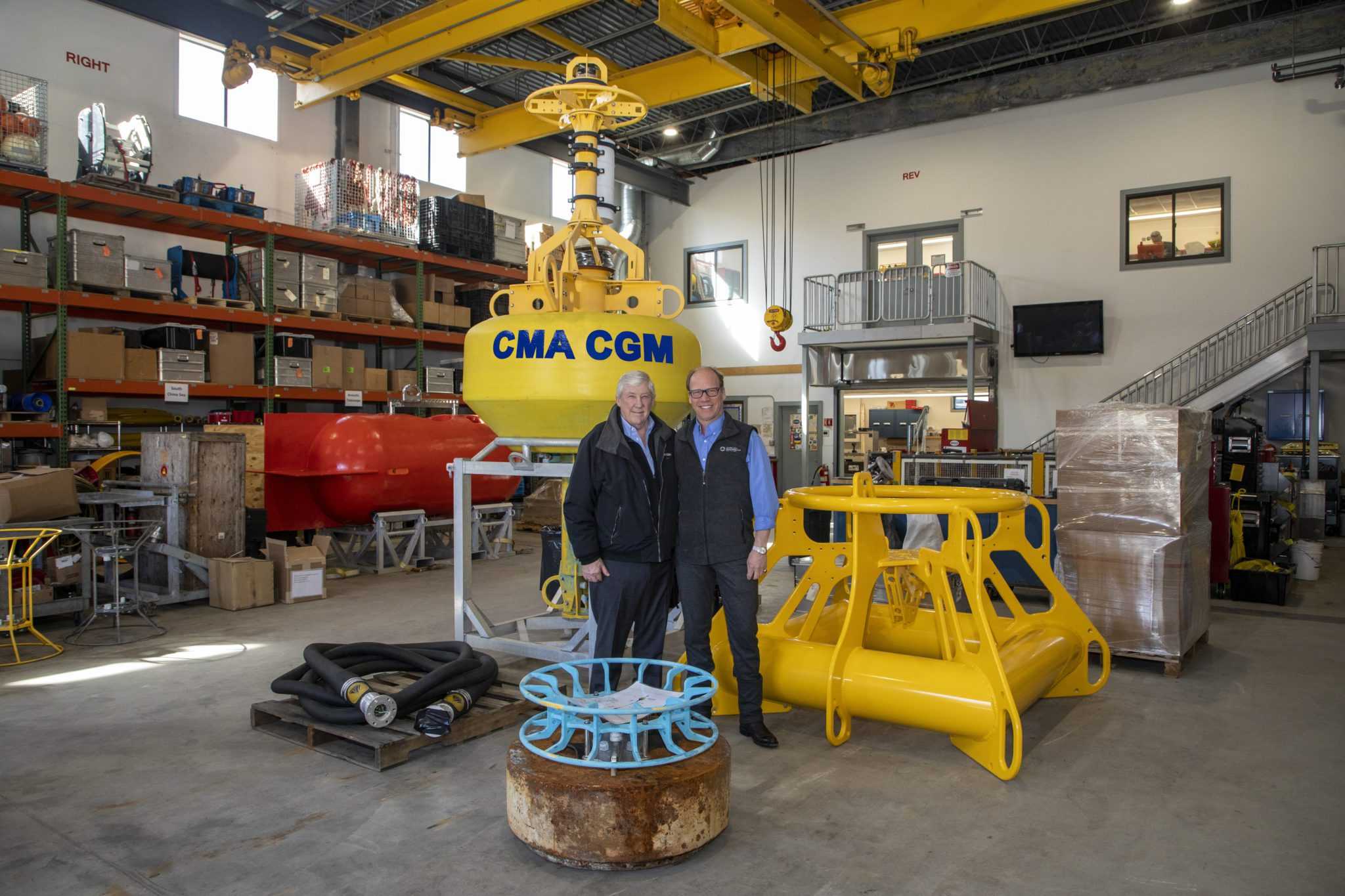WHOI collaborates with CMA CGM to increase protections for marine mammals

WHOI collaborates with CMA CGM to increase protections for marine mammals
 Ed Aldridge, President of CMA CGM America, and American President Lines, and Peter de Menocal, WHOI President and Director, with a CMA CGM branded DMON buoy. Photo by Jayne Doucette © Woods Hole Oceanographic Institution
Ed Aldridge, President of CMA CGM America, and American President Lines, and Peter de Menocal, WHOI President and Director, with a CMA CGM branded DMON buoy. Photo by Jayne Doucette © Woods Hole Oceanographic Institution
Newly located acoustic buoys will alert mariners of the presence of whales near critical U.S. ports
Woods Hole, MA – North Atlantic right whales are in trouble. As one of the most critically endangered species on the planet, their numbers are reaching a dangerous tipping point; deaths from fishing gear entanglements and ship strikes continue to outpace births, and the number of reproductive females is declining. Though they are protected under the Endangered Species Act and the Marine Mammal Protection Act, serious threats to their survival abound, and only approximately 336 of these great whales remain.
Now, a collaboration between Woods Hole Oceanographic Institution (WHOI) and the CMA CGM Group, a world leader in shipping and logistics, aims to increase whale detection efforts along the U.S East Coast, particularly for North Atlantic right whales, and reduce the potential for ship strikes along critical shipping routes. With funding from CMA CGM, who has long been committed to protecting the environment and preserving biodiversity through multiple initiatives in the US and worldwide, WHOI researchers will assemble and deploy two, near real-time passive acoustic monitoring buoys off the coast of Norfolk, Va., and Savannah, Ga., this year.
In addition to construction and deployment of the new buoys, WHOI and CMA CGM will lead the development of an industry consortium focused on reducing risks to right whales from vessels and supporting the continued operation of the WHOI-developed digital acoustic monitoring (DMON) buoys.

Drone aerial view of a pair of skim feeding North Atlantic right whales. Michael Moore and Carolyn Miller © Woods Hole Oceanographic Institution NOAA NMFS permit 21371
The highly urbanized and relatively shallow waters over the continental shelf of the eastern U.S. create a perilous superhighway for North Atlantic right whales, making them vulnerable to human activities like vessel strikes, entanglement in fishing gear and noise pollution. Every winter, many right whales, including pregnant females, travel more than 1,000 miles along the Atlantic coast to give birth in warmer southern waters, and then back north—a rare few with a calf in tow—to feed in northern waters.
Acoustic buoys play an important role in protecting marine animals. Each species of whale creates its own unique calls, and these new buoys will be equipped with a digital acoustic monitoring (DMON) instrument that will transmit information about detected sounds to shore every two hours. This WHOI technology can detect, classify, and report the sounds of marine mammals in near real-time from a variety of autonomous platforms, including moored buoys.
The data from the moored buoys are analyzed by an acoustician to determine which species are present, and results are displayed publicly on Robots4Whales and shared in near real-time with mariners and other stakeholders. This enables dynamic protections, including NOAA’s Slow Zones for Right Whales, which are areas with voluntary vessel-speed restrictions along the eastern seaboard that are established when right whales are detected.
Locations off the coast of Norfolk and Savannah were chosen for the new systems because the ports are among the busiest in the U.S., which often puts ships directly in the path of migrating whales. The new buoys will fill a critical gap in monitoring along the East Coast (see map).

Two new acoustic monitoring buoys will be deployed off the coast of Norfolk, Va. and Savannah, Ga. to help fill critical monitoring gaps along the U.S. East Coast, a busy migration route for North Atlantic right whales. Natalie Renier © Woods Hole Oceanographic Institution
“Adding these locations to our network of acoustic buoys is pivotal to providing more complete monitoring of the east coast of the United States,” explained Mark Baumgartner, project principal investigator and WHOI marine ecologist. “Vessel strikes are a major threat to large whales, so bringing awareness of the whales’ presence and increasing protection for them, particularly for the North Atlantic right whale, is incredibly important.”
“The technology that WHOI has developed using real time acoustic monitoring to determine the presence of North Atlantic right whales provides an inspired approach to efforts aimed at reducing vessel strike of these endangered species,” added Sofie Van Parijs, leader of the Passive Acoustic Research Group at NOAA’s Northeast Fisheries Science Center. “The rapid reporting of the presence of right whale calls allows this technology to be used for a wide range of applications, and NOAA increasingly uses this technology to address core monitoring and mitigation needs.”
Ed Aldridge, President of CMA CGM America, and American President Lines said, “At CMA CGM, we are dedicated to being stewards of the sea and finding BETTER WAYS to do business. The overall mission of this project is to advance research-driven, technological solutions for the shipping industry to responsibly share the ocean with marine mammals and protect endangered species. We’re honored to help put these protections in place and to lead the industry in a quest to prevent the extinction of the North Atlantic right whale.”

